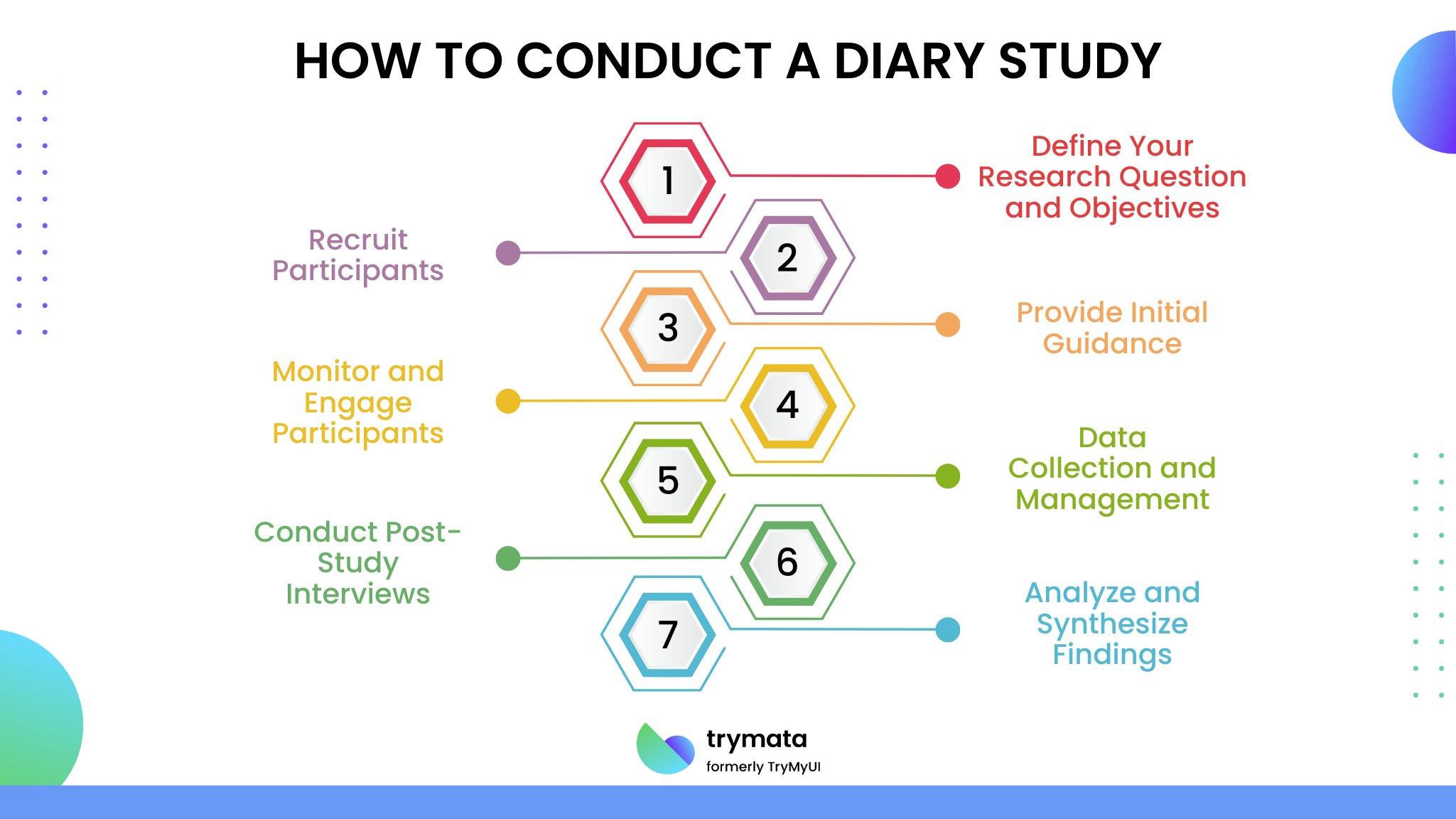A diary study is a research method used in usability testing to capture how participants interact with a product over time. Unlike traditional one-time usability tests, diary studies allow researchers to explore users’ experiences as they unfold in real time, providing rich, qualitative data directly from their everyday lives.
By having participants report their experiences, researchers gather continuous insights into how a product fits into the broader context of users’ lives.
This research method can be especially valuable in UX research as it enables designers and research teams to understand user interactions beyond a lab environment, uncovering issues and patterns that may not be apparent in a single-session test. Diary studies are adaptable, offering formats for various user needs and research goals.
In this blog, we will explore the concept of a diary study in usability testing, its types, when to conduct it, and how to run a successful diary study.
What is a Diary Study?
A diary study is a research method often used in usability testing to collect qualitative data about participants’ experiences over an extended period. In this method, research participants are asked to record their thoughts, actions, or reactions at different times or during particular events in their daily lives, often through diary entries.
This method provides deep, contextual insights into users’ real-world experiences as they interact with products, services, or systems over time.
Unlike traditional usability tests that occur in a controlled environment, diary studies capture in situ logging, allowing researchers to observe how study participants engage with the product or service in the natural flow of their everyday lives.
These diary entries are typically self-reported, which means they are subjective but offer valuable insights into the user’s emotional responses, challenges, and contexts that affect their behavior.
Why Should You Run a Diary Study?
Diary studies offer valuable insights into the user experience by capturing real-time, contextual user feedback. Here are key reasons why conducting a diary study is beneficial:
- Understanding Context: Diary studies capture user data as they interact with a product in their environments, revealing insights closer to users’ actual experiences than lab-based tests.
- Tracking Temporal Changes: Unlike one-time usability tests, diary studies reveal how user experiences evolve, essential for understanding longitudinal data and assessing products intended for frequent or complex use.
- Uncovering In-Situ Reactions: Diary studies enable in-situ logging, allowing users to document their experiences without relying on memory, which leads to more accurate, raw data.
- Exploring User Motivations and Frustrations: Users can express their thoughts candidly through personal diaries or log entries, helping researchers capture deep, personal insights that reveal both functional and emotional responses.
Types of Diary Studies
Different types of diary studies depend on the research objectives and the diary structure. The three most common types are:
1. Longitudinal Diary Study
This study collects data over a longer period, often weeks or months. Participants provide log entries regularly, documenting their thoughts, feelings, and behaviors related to the product or service. This type is ideal for understanding temporal dynamics and how users’ relationships with the product evolve.
2. Event-Contingent Diary Study
In this type, participants are asked to record their experiences only when a specific event occurs, such as using a product, encountering a particular issue, or experiencing an emotion. This helps to gather data related to particular events and offers a more targeted approach. For example, a signal contingent protocol might remind participants to log an entry when they experience certain triggers.
3. Interval-Contingent Diary Study
Research participants log entries at set intervals, such as daily or weekly. This method helps to capture insights into ongoing behaviors, attitudes, or experiences that may not be tied to specific events. It is particularly effective for studying recurring behaviors or experiences over time.
Each of these methods provides valuable insights into user behavior, but choosing the right type depends on the research questions and objectives of the study.
When to Conduct a Diary Study
Knowing when to conduct a diary study is essential for maximizing its effectiveness. Diary studies are most useful in the following situations:
- Understanding Long-Term Interactions: This is when you want to learn how users interact with your product or service over time, especially if the experience is extended, like using a mobile app or learning a new software tool.
- Collecting Rich, Contextual Data: If you want to capture data that reflects participants’ real-world experiences, such as how they incorporate a product into their daily routines and any challenges they encounter.
- Exploring Emotional Responses: Diary studies can be particularly useful in generative research, allowing users to express emotions, frustrations, or joy that might not emerge in structured environments like user interviews.
- Tracking Changes Over Time: Diary studies are a great tool if your product or service is undergoing continuous changes or if you want to gather data on how users’ perceptions evolve.
How to Conduct a Diary Study
Conducting a diary study requires a careful and well-planned approach to ensure the research objectives are met, the data collected is useful, and participants remain engaged throughout the process.

1. Define Your Research Question and Objectives
Before starting the study, defining clear research questions and objectives is crucial. What do you want to learn from the study? Are you trying to understand how users interact with a product over time, or are you focusing on specific pain points? Having these defined will guide the diary study tools and the structure of your study.
2. Recruit Participants
Recruiting participants is a key step. Choose the target user group that best represents your actual users. You’ll need to determine the number of participants needed. You may need fewer, highly engaged participants for longitudinal diary studies, as data collection is more intensive.
Incentives such as diary study incentives can be offered to encourage participation and ensure that participants remain engaged throughout the study. Consider offering small rewards after each entry or after the study.
3. Provide Initial Guidance
Once participants are selected, provide clear and detailed instructions on how to log their entries. Make sure participants understand what you’re asking for, the frequency of entries, and how detailed their logs should be.
Ensure the diary structure suits your research goals. For example, electronic diaries are ideal for tech-savvy participants, while paper diaries may be more suitable for others. Diary study tools can range from simple apps to more specialized diary study tools designed for research.
4. Monitor and Engage Participants
Throughout the study, it’s important to remind participants to make entries at the scheduled times. You can also check in with participants periodically to address questions and maintain their engagement. Keeping participants on track can prevent missing data and help ensure that the study provides detailed insights into their experiences.
5. Data Collection and Management
Data from participants’ log entries will be gathered as the study progresses. This data may come in the form of raw data, but it will need to be processed and analyzed. Ensure that the data analysis methods align with your research methods and will allow you to answer your research questions.
Depending on the type of diary study, you may need to analyze qualitative data (e.g., emotions, experiences) and quantitative data (e.g., frequency of interactions, number of entries).
6. Conduct Post-Study Interviews
To supplement the diary data, conduct post-study interviews to clarify any ambiguities or gain further context around specific entries. This can help provide deeper research insights and allow participants to elaborate on their experiences.
7. Analyze and Synthesize Findings
After data collection is complete, the research team will need to analyze the collected data to identify patterns, insights, and areas for improvement. This is where the richness of diary research shines, as it enables researchers to delve into the participants’ responses to see the nuances of user behavior over time.
The Pros and Cons of Diary Studies
Like all research methods, diary studies have their strengths and weaknesses. Here are the main advantages and disadvantages:
Pros:
- Contextual, Long-Term Insights: Diary studies offer a unique look into users’ real-world experiences over an extended period.
- Rich Qualitative Data: They capture personal reflections and emotional responses that are often missed in other methods.
- Captures Behavioral Changes: They help reveal how experiences evolve and how different external factors impact user behavior.
Cons:
- Participant Burden: Asking participants to record their experiences regularly can be time-consuming and lead to incomplete or missing data.
- Subjectivity: Since entries are self-reported, they may not always be accurate, and self-reported data can be influenced by bias or memory recall issues.
- Recruitment and Engagement Challenges: Keeping participants engaged over a long period can be difficult, and recruiting the right participants may require more effort.
Conclusion
Diary studies are a powerful research method for capturing authentic, in-depth insights into user behavior and experiences over time. By enabling participants to log their interactions and thoughts in real-life contexts, these studies provide valuable insights that other methods may miss.
Whether you’re exploring the temporal dynamics of user behavior, analyzing longitudinal data, or investigating specific events through structured or unstructured diary entries, this approach offers immense potential for UX research methods and beyond.
While diary studies have challenges, such as ensuring engaged participants and managing missing data, these can be mitigated with proper planning, clear and detailed instructions, and the use of specialized diary study tools. By integrating diary studies into your research projects, you can uncover the nuances of user interactions, identify pain points, and gather actionable insights that drive meaningful improvements in product design and user experience.
Incorporating diary studies into your toolkit will not only enhance your data collection efforts but also provide a foundation for future research, enabling your team to understand users’ everyday lives and create solutions that truly meet their needs.




